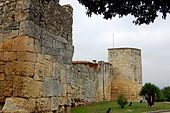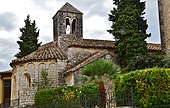Olèrdola
| Municipality of Olèrdola | ||
|---|---|---|
 Olèrdola - town view
|
||
| coat of arms | Map of Spain | |

|
|
|
| Basic data | ||
| Autonomous Community : |
|
|
| Province : | Barcelona | |
| Comarca : | Old Penedès | |
| Coordinates | 41 ° 19 ′ N , 1 ° 43 ′ E | |
| Height : | 189 msnm | |
| Area : | 30.08 km² | |
| Residents : | 3,692 (Jan 1, 2019) | |
| Population density : | 122.74 inhabitants / km² | |
| Postal code : | 08734, 08799 | |
| Municipality number ( INE ): | 08145 | |
| administration | ||
| Website : | www.olerdola.cat | |
Olèrdola is a municipality ( municipality ) with 3692 inhabitants (as of January 1, 2019) in the comarca of Alt Penedès in the province of Barcelona in the autonomous region of Catalonia . The municipality is divided into the old villages of Moja, Sant Miquel d'Olèrdola, Sant Pere Molanta and Viladellops and the new development areas of Can Trabal and Daltmar .
location
The villages of the municipality of Olèrdola are at an altitude of about 200 to 300 meters above sea level. d. M. about 54 kilometers (driving distance) west of Barcelona or about 17 kilometers northwest of the Mediterranean seaside resort of Sitges .
Population development
| year | 1960 | 1970 | 1981 | 1990 | 2000 | 2010 |
| Residents | 1,332 | 1,564 | 1,575 | 1,601 | 2,232 | 3,533 |
Since the 19th century, the municipality has recorded a slow but continuous growth in population, to which the two new building districts Can Trabal and Daltmar with a total of around 1,000 inhabitants have recently contributed.
economy
In the past, the inhabitants lived mainly as a self-sufficient living from agriculture , which also included growing wine and keeping cattle. In addition, Moja in particular served as a craft and mercantile center for the villages, hamlets and farmsteads in the area. The wine-growing still plays a major role - the locally produced white and red wines are the Denominació d'Origen Penedès marketed in Germany.
history
Olèrdola was already in the Neolithic , in the Bronze Age and in the 1st millennium BC. Populated by tribes of the Iberians . In Roman times, the fort built here was given an enclosure wall made of mighty stone blocks ( Cyclops masonry ). In the years 713/4, Muslim armies conquered the region, which was, however, recaptured early by the Counts of Barcelona , without repeated raids by the Moors could have been completely prevented. As a document by Sunyer I from the year 929 proves, the Roman fort was repaired and raised with rubble stone masonry in the early Middle Ages ; there is also talk of a new church. In 985 Almansor undertook a campaign in this area that partially destroyed the church. The Tumba Olèrdolana (or Tumba antropomórficas) are socialized, medieval tombs carved into the rock. Because of their large number in Olèrdola, they were given the name Tumbas Olèrdolana in Spain.
Attractions
- Sant Miquel d'Olèrdola
- Significant parts of the Roman and medieval walls of the 400-inhabitant town are still preserved.
- The unadorned rubble masonry of the rebuilt in 992 former parish church ( Esglesia Sant Miquel ) comes mostly still from the 10th century - only the increase in the Vierungsbereichs with a bell tower ( espadanya ) and the renewal of the portal for renewed destruction caused by parts of the army of Almoravides in 1108 are ingredients of the 12th century. During a renewed restoration of the church in 2011, traces of the Gothic and Renaissance style epochs as well as a cemetery with stone box graves hewn out of the rock were discovered, so that one must assume that the church was used as a parish church for a long time.
- A branch of the Museu d'Arqueologia de Catalunya was set up nearby in 1999 .
- The ruins of another Romanesque chapel ( Capella de Santa Maria ) are about five minutes' walk from the village.
- Moja
- The neo-Romanesque parish church of Sant Jaume in the center of the town with around 1400 inhabitants is a work of the 19th century.
- The immediately adjacent Romanesque church of Sant Esteve , built from a mixture of quarry and house stones, was built in the second half of the 11th century. The three beveled window frames provided apse shows a arcades structure with pilaster strips and a wide arched Fries under the eaves . On one wall of the interior of the church there is an early Gothic sarcophagus decorated with overlapping arches; it rests on two consoles with archaic heads.
- The watchtower Torre de Moja on the outskirts dates back to the 10th century, but was revised several times in later times.
- Viladellops
- The small village of Viladellops, with only 50 inhabitants, also has a medieval watchtower.
- The small Romanesque Capella Sant Joan has a round window and a simple bell gable above the west portal.
- Sant Pere Molanta
- The church of Sant Pere in the village with around 650 inhabitants dates from the 18th century.
literature
- Vicenç Buron: Esglésies Romániques Catalanes. Artestudi Edicions, Barcelona 1977, p. 42f, ISBN 84-85180-06-2 .
Web links
- Olerdola, history and buildings - photos + info (catalan)
- Olèrdola, historical buildings - links, photos + information (Catalan)
Individual evidence
- ↑ Cifras oficiales de población resultantes de la revisión del Padrón municipal a 1 de enero . Population statistics from the Instituto Nacional de Estadística (population update).







